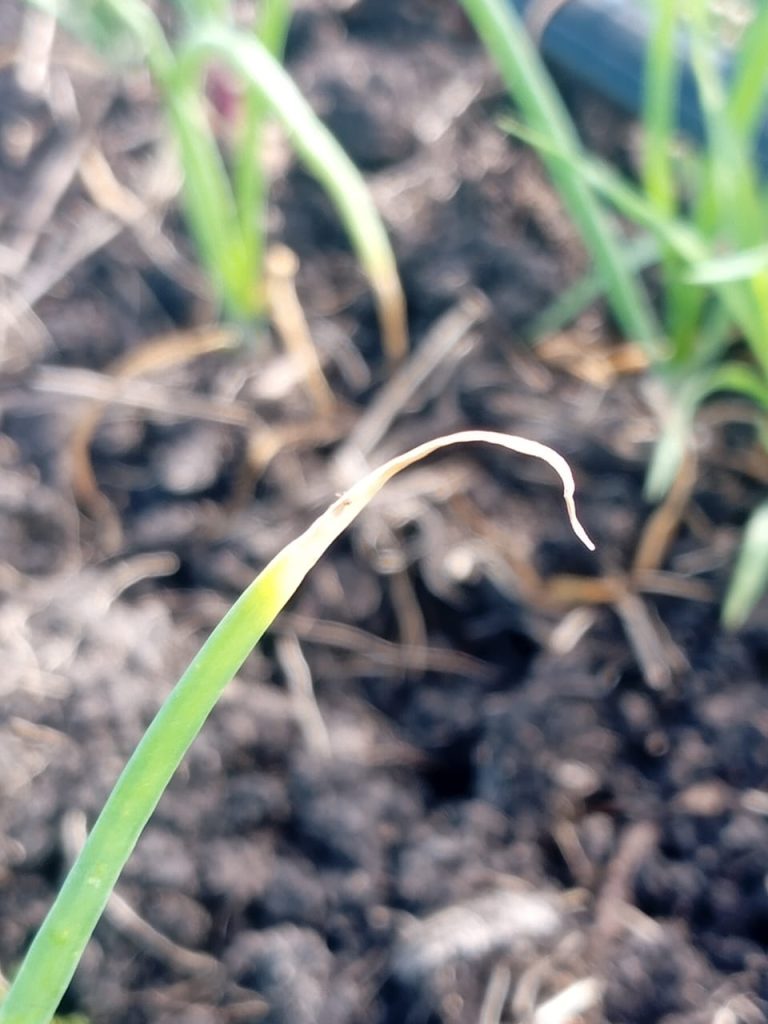Buckle up, garlic lovers, for a wild ride through the aromatic world of garlic farming in Kenya! At Onion Doctor Limited, we are dishing out a blog that is equal parts fun, feisty and packed with wisdom to keep your garlic crop grooving. Garlic farming in Kenya is hitting the jackpot- those bulbs fetch KES 200-250 per kilo in the markets! But, like uninvited ants at a picnic, diseases can munch on your profits. Do not sweat it! we are here to help you master garlic farming in Kenya with our climate-smart tricks, from drought- bustling seedlings to drip irrigation. Whether you are a rookie or a garlic guru, garlic farming in Kenya just got a whole lot spicier with our guide to outsmarting diseases. So, grab your farming hats and let us make garlic farming in Kenya the talk of the shamba with Onion Doctor`s expert vibes!

COMMON GARLIC DISEASES IN KENYA
1.DOWNEY MILDEW
Cause: The disease is caused by the oomycete pathogen Peronospora destructor, which infects garlic and other Allium species like onions and leeks. And thrives in Cool, moist environments with high humidity and moderate temperatures
Symptoms: Pale green to Yellow spots: Small, pale green or yellowish patches appear on the upper surface of the leaves and stalks.
Implications: Yield Loss: Severe infections can lead to significant reductions in garlic yield due to stunted growth and plant death. Post-Harvest Issues: Infected bulbs are prone to rot during storage, affecting marketability and leading to economic losses.

2. WHITE ROT
Cause: A soil-borne fungus called Sclerotium cepivorum
Symptoms: The disease is characterized by white, fluffy fungal growth at the base of the bulb, accompanied by the formation of small, black, seed-like structures on decaying tissue.Early signs include yellowing and wilting of the lower leaves, progressing to dieback. Infected plants often appear stunted and can be easily pulled from the soil due to root decay
Implication: Can lead to significant crop loss and soil contamination. Its spread can have serious economic implications, especially for commercial growers.

3.PURPLE BLOTCH
Cause: It is a fungal disease caused by Alternaria porri. It thrives in warm, humid conditions
Symptoms: Appear as small, sunken, whitish flecks on leaves and flower stalks. These lesions enlarge, developing purple centers with yellowish borders, and may coalesce to form large blotches.
Impact: Significantly impact yield and bulb quality if not properly managed.

4.RUST
Cause: Puccinia allii, a fungus affecting garlic and other Allium species. The fungus thrives in Cool temperatures.
Symptoms: Small white to yellow flecks on leaves. Flecks enlarge into orange blisters that release spores. Leaves may yellow, wither, and die prematurely.
Implications: Severe infections can lead to smaller bulbs and decreased overall yield.

5.FUSARIUM BASAL ROT
Cause: Caused by a soil-borne fungus known as Fusarium culmorum. The fungus thrives in warm conditions, so the disease is more common in the summer months.
Symptom: Initially presents as yellowing and dieback of leaf tips, progressing downward. Below ground, roots may rot and be replaced by white moldy growth, while bulbs exhibit brown, watery decay starting at the basal plate and spreading upward.
Implication: The most immediate impact of Fusarium basal rot is a reduction in yield. Affected plants often produce smaller bulbs, and in severe cases, the entire plant may die.

Image of Fusarium Basal Rot in Garlic
MANAGEMENT OF GARLIC DISEASES
Cultural Practices
Avoid planting Garlic in fields previously affected by diseases for at least 3–4 years
Crop Rotation: Rotate Garlic with non-Allium crops every 3–4 years to break disease cycles.
Sanitation: Remove and bury infected plant debris to reduce pathogen sources.
Proper Irrigation: Use drip irrigation systems from Onion Doctor Limited
Weed Control: Regularly remove weeds that can harbor pests and disease
Planting Practices: Use disease-free seeds and certified planting materials from Onion Doctor Limited
. Chemical Control
Fungicide Application: Apply fungicides judiciously, following recommended schedules and dosages. Rotate fungicides with different modes of action to prevent resistance.
| Week | Pesticide | Fungicides | Foliar | Fertilizer |
| Land Preparation | Decomposed Manure | |||
| 1 | Active Ingredient | Active Ingredient | First Top dressing | |
| 2 | Mancozeb | |||
| 3 | Profenofos | |||
| 4 | Acephale | Carbendazim |
Fun Fact: Did you know that Garlic protects against the common cold and may help with weight management: Loosing weight.
Contact us for: Onion seedlings, Garlic seedlings, Germinated garlic cloves, Farm planning services, Soil testing, training on onion and garlic growing, Drip irrigation installation and maintenance, Agronomic support, Onion and Garlic value pack and Farm management. For free consultation, placing orders or booking a visit with an agronomist, please contact us via Call or what’s app +254703982228, Email: Info@oniondoctor.co.ke. You can also check out our social media handles for daily updates on TikTok: https://www.tiktok.com/@oniondoctorke?_t=ZM-8wmsTu0qumO&_r=1 Instagram: https://www.instagram.com/oniondoctorke?igsh=MTVoaHF3aWUydTJzaQ==Facebook:https://www.facebook.com/share/16SwgYn2dG/ Youtube:https://youtube.com/@oniondoctorke?si=u5Jnd-r0qU9UDYqL and Twitter: https://x.com/OnionDoctorKe?t=FR3JXlS_oN1vjjUgAtfyzg&s=09